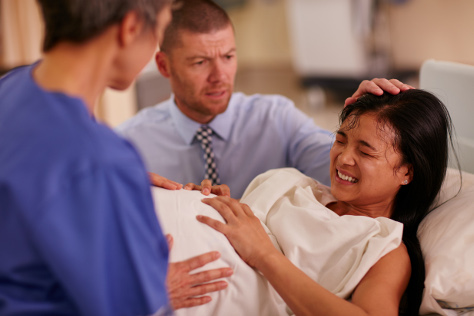Birth complications explained for partners
Midwives are well used to dealing with most of these difficulties and they don't necessarily mean a drama. And there are always doctors available if things get really difficult.

Here are some of the more common complications.
Breech babies
In 'normal' births the baby is born head-first and if you think about it, it's obvious that babies have to be upside down. Occasionally the baby is the wrong way around just before birth, with feet and bottom first - a 'breech presentation.'
The doctor will try to turn the baby around - using a scan to see what's going on - by putting her hands on the bump and gently pushing the baby into the right position. If this doesn't work, it's still possible to have a normal delivery with the baby in a breech position, but the doctor will advise what's best depending on circumstances.
Special deliveries
Some babies need some extra help to be born. This can be when the baby
- gets into a difficult position
- shows signs of distress
- has shoulders that are a bit too broad
- is very tired, maybe after a long, exhausting labour
When this happens, the medical staff have a couple of tools to help gently pull the baby out
- Forceps - curved metal tongs - to hold the baby's head
- Ventouse - a vacuum cap that attaches to the baby's head
When these tools are used it's called an 'assisted delivery'. The mother has to lie on the bed with her feet in stirrups and she might need an episiotomy to help - see below for what this is. She'll still have to push in the normal way and the midwife will work with her to help ease the baby out. Baby might have some marks on the head from an assisted birth, but these fade after a few days.
Episiotomy
This is a small cut made under local anaesthetic in the perineum - the area between the vagina and the anus. It's made to prevent the skin tearing. With care and attention to basic hygiene, the cut will heal quite quickly and leave no lasting effects.
Induction
Sometimes labour must be started artificially - called induction. This usually happens if there is a risk to the mother's or the baby's health, like high blood pressure or when the baby isn't growing normally. It's normally planned in advance, so there's plenty of time to talk it through with the midwife or doctor.
Contractions can be started by inserting a special pessary into her vagina (a pessary is a little bullet of solid medicine that dissolves in the warmth of the body) or by a hormone drip inserted in her arm.
C-section
There are situations where it's safest for the baby to be born by Caesarean or C-section. This involves major surgery, so it will only be done this way if there is a real medical need.
What happens is that the baby is delivered by cutting through the mother's abdomen and into the womb. The baby is then lifted out.
There are two types of Caesarean:
-
Elective - that is, planned in advance. It may be recommended if the midwife and doctor believe a normal birth would be dangerous for either the mother or the baby, maybe as the result of a medical condition.
-
Emergency - if there are complications in labour, your partner may need an emergency caesarean
Caesareans are always performed under anaesthetic. Your partner may have a spinal epidural and if she already has an epidural catheter for pain relief in labour, then all the anaesthetist need do is put a stronger dose of local anaesthetic down the catheter. A spinal is a single injection, that lasts for about 30-60 minutes, depending on the dose, but if the need is more urgent your partner may require a general anaesthetic because it's quicker.